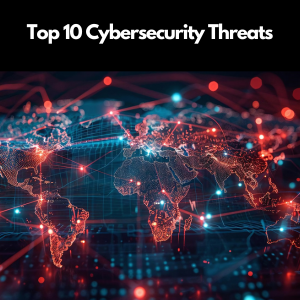Cyberattacks have become a modern battlefield. Hostile nations wield them to disrupt communications, destabilize institutions, and assert geopolitical power—warfare without missiles but with equally devastating effects. Digital terrorism targets critical infrastructure and economies, spreading fear and chaos at scale. Organized crime has embraced cyber tools, using phishing, malware, and scams to extort money and steal identities, mirroring traditional crime but with a global reach. Independent hackers, driven by personal gain, revenge, or ideology, continuously evolve their tactics to rise in the hacker ranks. Employees, contractors, or partners with insider access may exploit it for financial or personal motives, while external actors masquerading as insiders further blur the lines.
Here we explore the most relevant 10 cybersecurity threats you should be aware of in 2024:
- Social Engineering: Exploiting Human Weaknesses
Social engineering remains one of the most effective hacking methods, preying on human error: it drives 98% of cyberattacks, with businesses facing over 700 attempts annually. Alarmingly, 90% of data breaches exploit human vulnerabilities to access sensitive information (Splunk). Tactics like phishing, spoofing, and whaling have become even more dangerous with advancements in AI and deepfakes. Personalized phishing attempts are now almost indistinguishable from legitimate communications, forcing companies to double down on employee training and awareness. In mid-2024, Microsoft Threat Intelligence identified the financially motivated group Storm-1811 exploiting Microsoft Teams and Quick Assist for social engineering attacks (Microsoft). Using Teams to impersonate IT staff, the group deployed tools like EvilProxy and SystemBC for credential theft and persistence.
- Third-Party Exposure: Weak Links in the Chain
Cybercriminals frequently exploit less secure third-party vendors to access larger targets. In 2023, nearly 30% of data breaches were linked to third-party vulnerabilities (Security Scorecard). Although large organizations often invest heavily in advanced cybersecurity measures, smaller vendors supporting them may lack the resources or expertise to implement even basic protections. Attackers know this and exploit these vendors as gateways to larger, more lucrative targets. A recent example is the AT&T breach, which exposed sensitive data from over 70 million customers (PCMag). Smaller vendors often lack robust security measures, making them easy entry points for attackers. Strong third-party risk management protocols, including regular audits and limited access permissions, are essential for mitigating this threat.
- AI-Driven Threats: A New Frontier
Paradoxically, AI has revolutionized both sides of the cybersecurity battle. Attackers use machine learning to automate phishing campaigns and analyze vulnerabilities, while defenders employ AI for real-time threat detection and system protection. However, AI-driven attacks have escalated in both frequency and sophistication. Deepfake technology, for instance, has been used to impersonate executives, leading to significant financial losses. While 85% of cybersecurity professionals cite AI as a driver of rising attacks, AI-powered defense systems are also helping businesses stay ahead by identifying threats faster than ever before.
- Denial-of-Service (DoS) Attacks
DoS attacks are relentless in their disruption, targeting systems with overwhelming traffic to render them unusable. In 2022, ransom-related DDoS attacks surged by 67%. These attacks aren't just increasing in frequency—they're evolving in sophistication. A single DDoS campaign can involve millions of devices, often hijacked from unsuspecting users via botnets (Cloudflare). Techniques vary, but their impact is undeniable. HTTP floods trick systems with legitimate-looking requests, draining resources, while SYN floods exploit connection handshakes to stall servers. Throughout 2024, the Internet Archive experienced a series of distributed DoS attacks, causing intermittent service disruptions over several days – with the latest one being reported in October 2024 (Forbes).
- Injection Attacks
Injection attacks are digital time bombs, allowing attackers to embed malicious commands into applications. SQL injection, one of the most notorious types, is responsible for 23% of all web application vulnerabilities worldwide (Statista). These attacks exploit systems by injecting rogue database queries, often through input fields, compromising sensitive information. In August 2024, Security researchers Ian Carroll and Sam Curry uncovered a vulnerability in FlyCASS, a web-based service used by some airlines to manage TSA's Known Crewmember (KCM) program and the Cockpit Access Security System (Bleeping Computer). The flaw could allow unauthorized individuals to bypass airport security and access aircraft cockpits.
- Man-in-the-Middle (MitM) Attacks
MitM attacks involve cybercriminals intercepting and potentially altering communications between two parties without their knowledge, aiming to steal sensitive information or inject malicious content. These attacks compromise data integrity and confidentiality, affecting individuals and organizations across various sectors. Companies like Cisco and Symantec offer solutions to detect and prevent MitM attacks. However, the emergence of quantum computing presents new challenges to traditional encryption methods used to thwart these attacks. IBM's research indicates that MitM attacks accounted for 35% of exploits observed in cloud environments, underscoring their prevalence.
- Supply Chain Attacks
Supply chain attacks target vulnerabilities within an organization's network of suppliers and partners, aiming to infiltrate secure systems by exploiting trust relationships between businesses. These attacks can impact organizations of all sizes and potentially affect entire industries. The complexity of modern supply chains makes these attacks particularly challenging to detect and mitigate. Gartner predicts that by 2025, 45% of organizations worldwide will have experienced attacks on their software supply chains. A notable incident in 2024 involved a ransomware attack on Blue Yonder, a prominent supply chain technology provider. This breach disrupted operations for major retailers, including Starbucks and UK grocery chains Sainsbury's and Morrisons, affecting their ability to manage employee schedules and pay (The Wall Street Journal).
- Ransomware Attacks
Disruptive and costly ransomware attacks have become a growing menace in the digital landscape. Ransomware often enters systems through phishing emails, malicious downloads, or exploiting unpatched vulnerabilities. Once inside, it spreads across networks, locking files and sometimes turning off entire infrastructures. Some ransomware strains, like LockBit or Black Basta, now employ double-extortion tactics—demanding payment not only for data recovery but also to prevent the public release of stolen data. The average ransom demand has surged to $2.73 million in 2024, marking an increase of nearly $1 million compared to 2023 (Sophos). In 2024, cybercriminals have taken ransomware to a new level, leveraging detailed reconnaissance to demand higher ransoms. A striking example was the attack on Starbucks' scheduling system, which left employees scrambling to track hours and disrupted payroll operations (CNN) manually.
- Cloud Security
We have witnessed how rapid adoption of cloud computing has revolutionized data management and operational efficiency. But it has also introduced significant security challenges, particularly concerning misconfigurations and weak access controls, leading to unauthorized access and substantial data breaches. Misconfigurations, such as unrestricted outbound access, disabled logging, and exposed access keys, are common pitfalls in cloud environments. In 2024, the Snowflake data breach exposed sensitive corporate information, marking one of the largest cloud-related incidents of the year (Wired). Similarly, AT&T experienced a breach that compromised nearly all its customer data due to third-party platform vulnerabilities (Spiceworks).
- IoT Attacks
From smart thermostats and fitness trackers to industrial control systems and medical devices, IoT devices often prioritize functionality over security. Many operate with minimal defenses, making them easy targets for cybercriminals. Vulnerabilities in IoT networks can open the door to large-scale breaches, data theft, or even critical infrastructure sabotage. SonicWall's 2024 Mid-Year Cyber Threat Report reveals a concerning escalation in cyberattacks, with organizations facing critical threats for an average of 50 hours within a standard 40-hour workweek. This intense assault translates to 125% of the working week under attack.
Bottom Line
Every click, every connection, and every device are a potential gateway for attackers. Each of these ten threats point out towards the pressing question: Are we prepared to defend what matters most? The question isn’t if your organization will face a cyber threat—it’s when. The only choice you have is how prepared you’ll be to meet.
.png?width=1816&height=566&name=brandmark-design%20(83).png)



